Full Text Searchable PDF User Manual
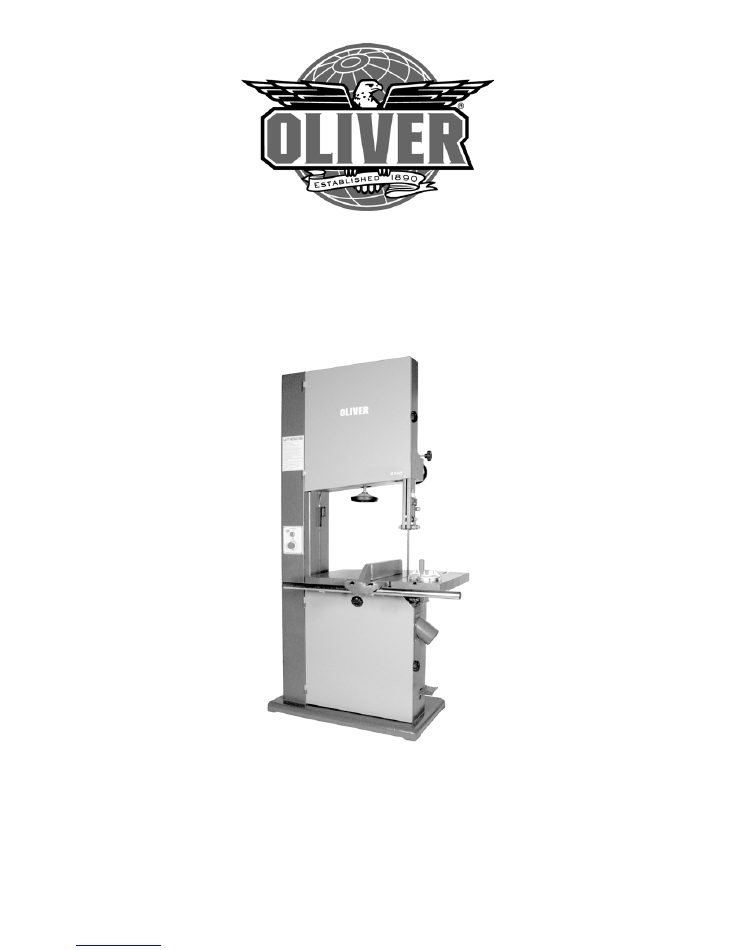
4640 and 4665 Bandsaw 20” and 24”
Owner’s Manual
Oliver Machinery
M-4640 9/2003
Seattle, WA
Copyright 2003
info@olivermachinery.net
www.olivermachinery.net

Warranty
Thank you for your purchase of a genuine Oliver woodworking machine. Oliver Machinery has made
every attempt to provide a machine that is safe and durable.
All Oliver products are guaranteed, to the ORIGINAL RETAIL CUSTOMER, to be free from defects for
TWO YEARS FROM THE DATE OF PURCHASE. Oliver Machinery will repair or replace, at its option,
any component that fails under normal use. Please note that the customer is responsible for returning the
failed component to Oliver Machinery prepaid for inspection.
This warranty does not cover damages caused by misuse, accident, unauthorized repair, alteration or
improper maintenance.
Warning
Read this manual thoroughly before operating the machine. Oliver Machinery disclaims any liability for
machines that have been altered or abused. Oliver Machinery reserves the right to effect at any time,
without prior notice, those alterations to parts, fittings, and accessory equipment which they may deem
necessary for any reason whatsoever.
For More Information
Oliver Machinery is always adding new Industrial Woodworking products to the line. For complete, up-to-
date product information, check with your local Oliver Machinery distributor, or visit
www.olivermachinery.net
2

WARNING
Read this manual completely and observe all warning labels on the machine. Oliver Machinery has made
every attempt to provide a safe, reliable, easy-to-use piece of machinery. Safety, however, is ultimately
the responsibility of the individual machine operator. As with any piece of machinery, the operator must
exercise caution, patience, and common sense to safely run the machine. Before operating this product,
become familiar with the safety rules in the following sections.
•
Always keep guards in place and in proper operating condition.
•
Keep hands out of line with the saw blade.
•
Use a push stick.
1.
If you are not properly trained
in the use of a bandsaw do not use until the proper training has been
obtained.
2.
Read, understand and follow
the safety instructions found in this manual. Know the limitations and
hazards associated with this machine.
3.
Electrical grounding:
Make certain that the machine frame is electrically grounded and that a
ground lead is included in the incoming electrical service. In cases where a cord and plug are used,
make certain that the grounding plug connects to a suitable ground. Follow the grounding procedure
indicated in the National Electrical Code.
4.
Eye safety:
Wear an approved safety shield, goggles, or glasses to protect eyes. Common
eyeglasses are only impact-resistant, they are not safety glasses.
5.
Personal protection:
Before operating the machine, remove tie, rings, watch and other jewelry and
roll up sleeves above the elbows. Remove all loose outer clothing and confine long hair. Protective
type footwear should be used. Where the noise exceeds the level of exposure allowed in Section
1910.95 of the OSHA Regulations, use hearing protective devices. Do not wear gloves.
6.
Guards:
Keep the machine guards in place for every operation for which they can be used. If any
guards are removed for maintenance, DO NOT OPERATE the machine until the guards are
reinstalled.
7.
Work area:
Keep the floor around the machine clean and free of scrap material, saw dust, oil and
other liquids to minimize the danger of tripping or slipping. Be sure the table is free of all scrap,
foreign material and tools before starting to use the machine. Make certain the work area is well
lighted and that a proper exhaust system is used to minimize dust. Use anti-skid floor strips on the
floor area where the operator normally stands and mark off machine work area. Provide adequate
work space around the machine.
8.
Material condition:
Do not attempt to saw boards with loose knots or with nails or other foreign
material. Do not attempt to saw twisted, warped, bowed stock.
9.
Operator position:
Maintain a balanced stance and keep your body under control at all times.
10.
Before starting:
Before turning on machine, remove all extra equipment such as keys, wrenches,
scraps, and cleaning rags away from the machine.
11.
Careless acts:
Give the work you are doing your undivided attention. Looking around, carrying on a
conversation, and “horseplay” are careless acts that can result in serious injury.
3

12.
Disconnect all power sources:
Before performing any service, maintenance, adjustments or when
changing blades. A machine under repair should be RED TAGGED to show it should not be used
until the maintenance is complete.
13.
Job completion:
If the operator leaves the machine area for any reason, the bandsaw should be
turned "off" and the blade should come to a complete stop before their departure.
14.
Replacement parts:
Use only genuine Oliver Machinery factory authorized replacement parts and
accessories; otherwise the warranty and guarantee is null and void.
15.
Misuse:
Do not use this Oliver bandsaw for other than its intended use. If used for other purposes,
Oliver disclaims any real or implied warranty and holds itself harmless for any injury or damage which
may result from that use.
16.
Drugs, alcohol and medication:
Do not operate this machine while under the influence of drugs,
alcohol, or any medication.
17.
This machine is deigned
for cutting wood products only. Do not use to cut any kind of metal or
substance other then wood.
18.
Never start the saw
while a workpiece is in contact with the blade.
19.
Make sure
the blade is running in the proper direction. The teeth should be pointing down at the
point the blade enters the table viewing from the front of the saw.
20.
Health hazards:
Some dust created by power sanding, sawing, grinding, drilling and other
construction activities contains chemicals known to cause cancer, birth defects or other reproductive
harm. Some examples of these chemicals are:
•
Lead from lead-based paint.
•
Crystalline silica from bricks and cement and other masonry products.
•
Arsenic and chromium from chemically-treated lumber.
Your risk from these exposures varies, depending on how often you do this type of work. To reduce
your exposure to these chemicals, work in a well-ventilated area, and work with approved safety
equipment, such as those dust masks that are specifically designed to filter out microscopic particles.
Familiarize yourself with the following safety notices used in this manual:
CAUTION:
(This means that if precautions are not heeded, it may result in minor or moderate injury
and/or possible machine damage)
WARNING:
(This means that if precautions are not heeded, it could result in serious injury or possibly
even death).
4

Table of Contents
Page Number
Warranty........................................................................................................................................................ 2
Warnings ....................................................................................................................................................3-4
Table of Contents.......................................................................................................................................... 5
Specifications ................................................................................................................................................ 5
Contents of the Shipping Containers ............................................................................................................ 6
Uncrating the Machine .................................................................................................................................. 6
Machine Preparation and Setup ................................................................................................................... 6
Table Assembly............................................................................................................................................. 7
Dust Chute Assembly.................................................................................................................................... 7
Installing Blade.............................................................................................................................................. 8
Tensioning Blade .......................................................................................................................................... 8
Blade Tracking .............................................................................................................................................. 9
Adjusting Upper Blade Guides...................................................................................................................... 9
Adjusting Lower Blade Guides.................................................................................................................... 10
Squaring Table to the Blade ....................................................................................................................... 10
Fence and Rail Adjustment ......................................................................................................................... 11
Electrical Connections............................................................................................................................11-12
Miter Gauge ................................................................................................................................................ 12
Dust Collection ............................................................................................................................................ 12
Brake Pedal................................................................................................................................................. 12
Tilting the Table........................................................................................................................................... 12
Removing Blades ........................................................................................................................................ 13
Replacing V-Belt ......................................................................................................................................... 13
Adjusting Belt Tension ................................................................................................................................ 13
Maintenance................................................................................................................................................ 14
Lubrication................................................................................................................................................... 14
Troubleshooting .......................................................................................................................................... 15
Specifications
Model No..............................................................4640 .......................................................................... 4655
Stock No...............................................................4640.001 (3HP, 1Ph) ...................... 4655.001 (5HP, 1Ph)
.............................................................................4640.002 (5HP, 3Ph) ................... 4655.002 (7.5HP, 3Ph)
Blade Speed (SFPM) ...........................................4,000 ........................................................................ 5,000
Wheel Diameter (in.) ............................................20 .................................................................................. 24
Table Dim. (WxL/in.) ............................................26-3/4 x 20-1/2..........................................31-1/2 x 23-3/4
Throat Distance (in.).............................................19 .................................................................................. 23
Max. Stock Height (in.).........................................11-1/4......................................................................13-3/4
Blade Length (in.).................................................157 .............................................................................. 176
Blade width Cap. (in.)...........................................1/4 to 1-1/4............................................................ 1/4 to 2
Table Height at 90° (in.) .......................................33-3/4......................................................................34-1/2
Table Tilt Limits ....................................................0° to 45° .............................................................. 0° to 45°
Motor ....................................................................3HP, 1Ph............................................................5HP, 1Ph
.............................................................................
220V Only
........................................................
220V Only
.............................................................................5HP, 3Ph, 220V/440V.................7.5HP, 3Ph, 220V/440V
.............................................................................
Prewired 220V
........................................
Prewired 220V
Gross Weight (lbs.) ..............................................750 .............................................................................. 900
5
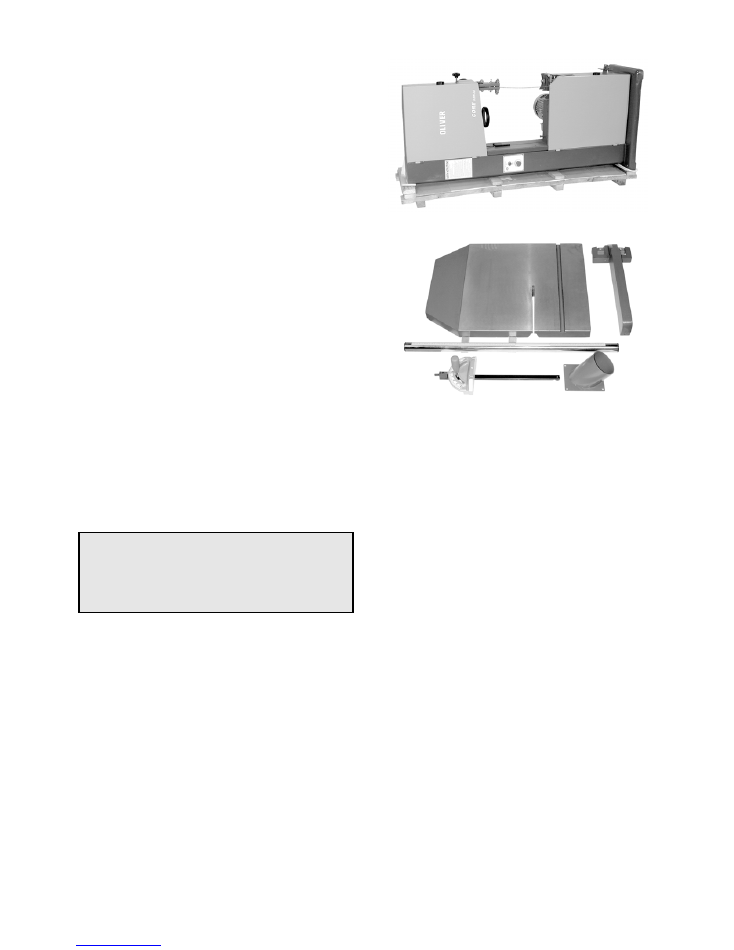
Contents of the Shipping Containers
Oliver 4640 – 20” Bandsaw
1. 20”
Bandsaw
1. Miter
Gauge
1. Table and Rail Assembly
1. Fence
1. Dust
Chute
Oliver 4655 – 24” Bandsaw
1. 24”
Bandsaw
1. Miter
Gauge
1. Table and Rail Assembly
1. Fence
1. Dust
Chute
Uncrating the Machine
For protection against shifting during transport,
the base of bandsaw was bolted to the shipping
crate in two places. Remove these carriage
bolts. Carefully uncrate the machine and remove
the plastic bag. Be careful not to allow the table
to fall to the ground during unpacking. Inspect
the unit for signs of shipping damage. If
damage is found, contact your dealer
immediately. Retain all packaging materials in
case it becomes necessary to ship the machine
back to the dealer or to another site.
Machine Preparation and Setup
!
WARNING
The equipment used to lift this machine must
have a rated capacity at, or above the weight
of the bandsaw. Failure to comply may
cause serious injury!
The bandsaw must be positioned on a smooth,
level surface. The area must be well lit and
have plenty of room to maneuver with large
pieces of wood.
Level the saw front to back and side to side
using a level placed on the table. Use shims
under the corners, if necessary, but make sure
the saw is stable before being placed into
service.
Clean all rust protected surfaces with a
commercial solvent. Do not use acetone,
gasoline, lacquer thinner or any type of
flammable solvent, or a cleaner that may
damage paint. Cover cleaned surfaces with
WD-40 or a 20W machine oil.
6
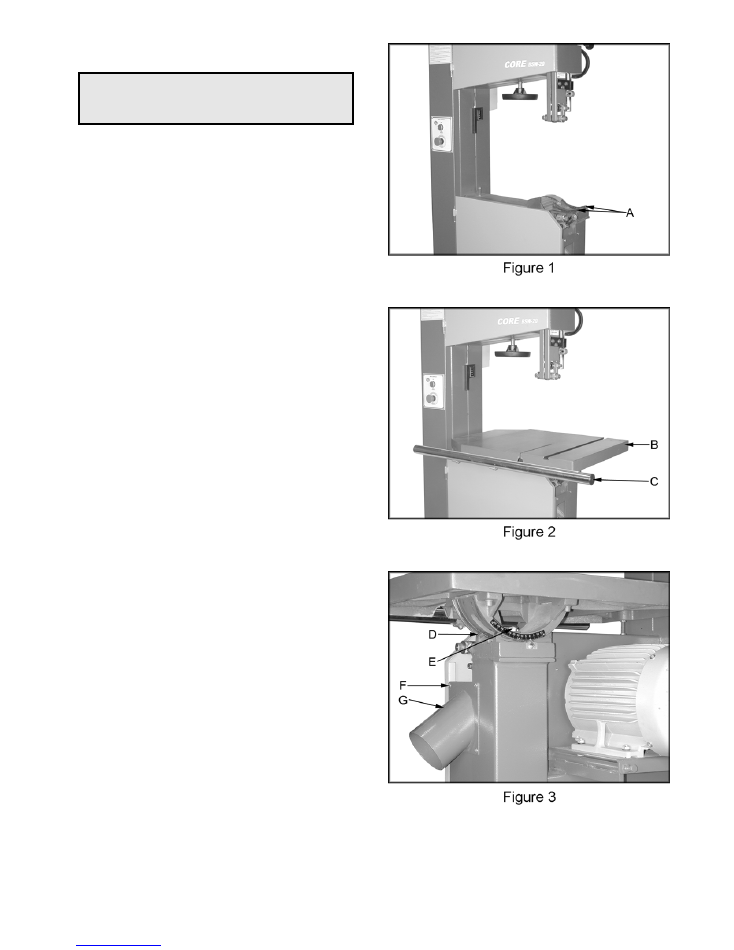
Table Assembly
CAUTION!
The table is heavy. Use the help of another
person to lift and position the table.
1.
Disconnect machine from power source.
2. Grease the trunnions (A, Figure 1) on
bandsaw prior to assembling table.
3. Installing the table (B, Figure 2) is easiest if
the blade is out of the way. The blade
tension is loose as sent from the factory.
Open upper and lower doors completely and
remove the blade. Wear leather work
gloves to protect your hands.
4. Remove the table mounting bolt and washer
from the bandsaw trunnion.
5. Lift the table and carefully align the
trunnions. Make certain the fence rail (C,
Figure 2) is positioned at the front side of the
bandsaw.
6. Make sure the trunnions are lined up
properly (D, Figure 3) and secure the table
by threading the bolt (E, Figure 3) into the
threaded hole in frame trunnion.
Dust Chute Assembly
Mount dust chute (G, Figure 3) with the provided
screws (F, Figure 3) to the bandsaw frame.
7
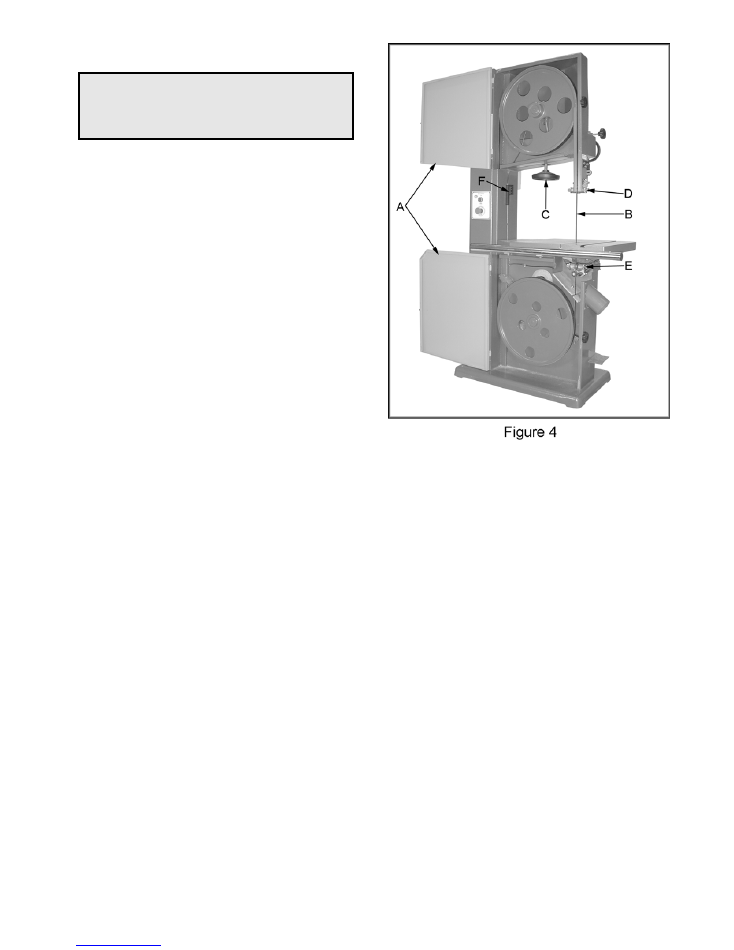
Installing Blade
!
WARNING
Bandsaw blades are sharp so be very careful
while handling. Failure to comply may cause
serious injury!
1.
Disconnect machine from power source.
2. Open upper and lower doors (A, Figure 4).
3. Put on leather gloves to protect your hands
from the sharp teeth of blade.
4. Slide blade through table slot, ensuring that
the teeth are pointing down toward the table.
5. Center the blade (B, Figure 4) on both the
upper and lower wheels. Carefully thread
the blade through the upper and lower blade
guides as shown in Figure 4.
Note:
It may
help to move the upper wheel down. This
can be accomplished by rotating the
handwheel (C, Figure 4).
Tensioning Blade
Proper blade tension is essential to any cutting
operation on a bandsaw. Too little, or too much
blade tension can cause blade breakage and/or
poor cutting performance. Tension will very
depending the blade being used and the type of
material being cut.
1.
Disconnect machine from power source.
2. At this point the blade should be properly
positioned, but slack. Increase tension on
the blade by rotating tensioning handwheel
(C, Figure 4).
3. Move the upper guide assembly (D, Figure
4) and lower guide assembly (E, Figure 4) if
they interfere with the blade during
tensioning.
4. A reference gauge (F, Figure 4) indicates
the approximate tension setting.
Note:
After setting tension and achieving the
desired results make a note of what the
tension gauge reads for the particular blade.
This will help you get back to the desired
tension if the particular blade has been
removed or tension released. Keep in mind
that blades will last longer if you release
tension when not in use. Also, new blades
will often stretch with use, and not all blades
will be exactly the same length. Use blade
tension gauge as a guide for individual
blades.
8
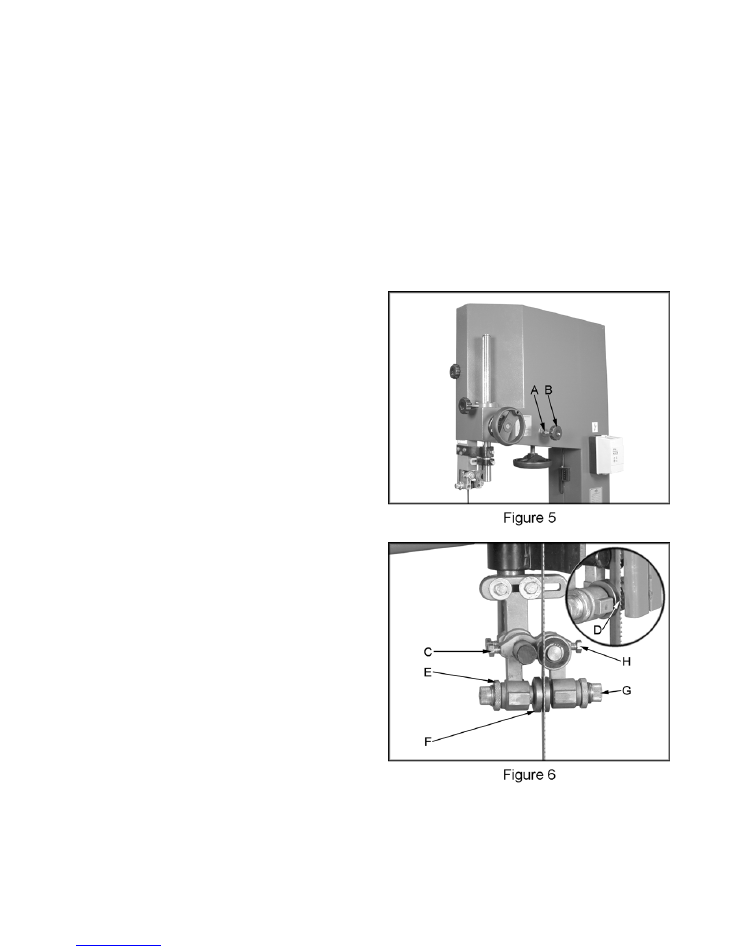
Blade Tracking
Blade tracking has been adjusted at the factory
and shouldn’t need any adjustment. If you are
experiencing a problem follow the below listed
steps.
1.
Disconnect machine from power source.
2. Blade must be properly tensioned before
adjusting blade tracking, see “Tensioning
Blade” page 8. Move the upper guide
assembly and lower guide assembly if they
interfere with the blade.
3. Open upper wheel door and rotate the wheel
forward by hand. Observe position of the
blade on the wheel. The blade should rest
in approximately the center of the wheel.
4. If adjustment is necessary, loosen the hex
nut (A, Figure 5).
5. Adjust tracking by turning the knob (B,
Figure 5) in 1/4 turn increments. Rotate
wheel forward, and observe the position of
blade on the wheel. Rotating the knob
counter-clockwise will move the blade
towards the front of the wheel. Rotating the
knob clockwise will move the blade towards
the back of the wheel.
6. Continue with adjustments until the blade is
tracking properly.
7. Tighten the hex nut (A, Figure 5) while
holding knob (B, Figure 5).
Adjusting Upper Blade Guides
The blade guard has been removed in Figure 6
for photo purposes only.
1.
Disconnect machine from power source.
2. Blade tension and tracking must be properly
adjusted prior to blade guide setup, see
“Tensioning Blade” page 8 and “Blade
Tracking” page 9.
3. Loosen bolt (C, Figure 6) and position the
blade guide assembly so that the guides rest
just behind the gullet of the blade teeth (D,
Figure 6). Tighten the bolt.
4. Loosen the knurled jam nuts (E, Figure 6)
that lock the guides (F, Figure 6) in place.
5. Turn the knurled knob (G, Figure 6) so that
the guides rest lightly against the blade,
approximately 0.003” away from the sided of
the blade, about the thickness of a piece of
paper. .
Do not
force the guides against
the side of the blade. Tighten knurled jam
nuts while holding the knurled knobs.
6. Adjust the blade support bearing so that it is
0.003” away from the back of the blade,
about the thickness of a piece of paper. To
make this adjustment loosen bolt (H, Figure
6) and slide the bearing and bearing post
into position. Tighten the bolt.
Note:
For best results the upper blade
guide should be lowered so that it is just
above the workpiece while cutting.
9
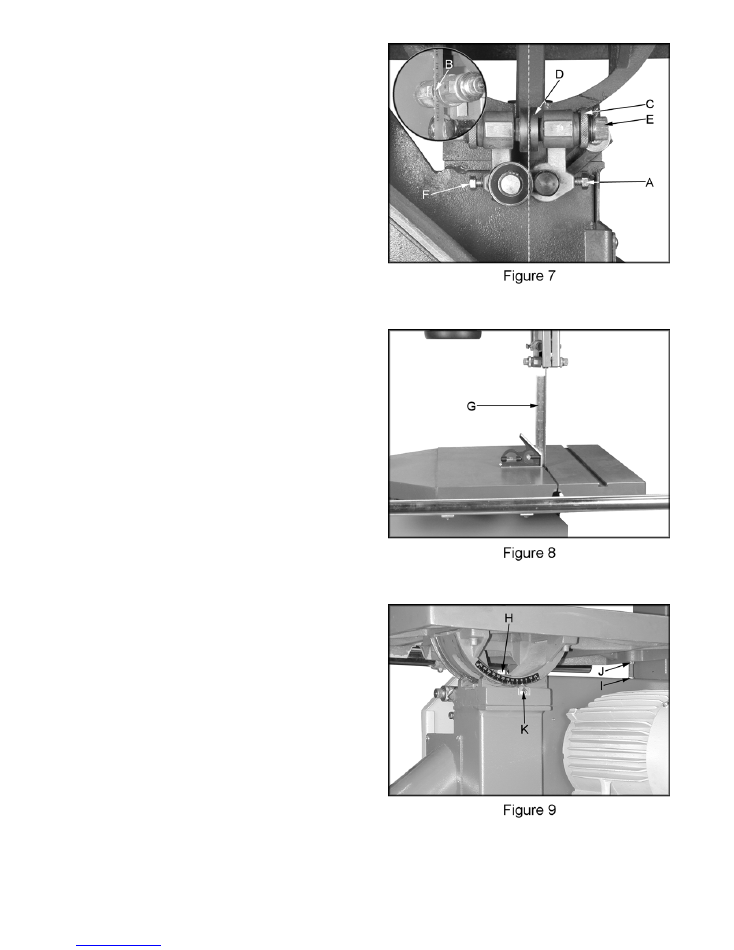
Adjusting Lower Blade Guides
1.
Disconnect machine from power source.
2. Blade tension and tracking must be properly
adjusted prior to blade guide setup, see
“Tensioning Blade” page 8 and “Blade
Tracking” page 9.
3. Loosen bolt (A, Figure 7) and position the
blade guide assembly so that the guides rest
just behind the gullet of the blade teeth (B,
Figure 7). Tighten the bolt.
4. Loosen the knurled jam nuts (C, Figure 7)
that lock the guide (D, Figure 7) in place.
5. Turn the knurled knob (E, Figure 7) so that
the guides rest lightly against the blade,
approximately 0.003” away from the side of
the blade, about the thickness of a piece of
paper.
Do not
force the guides against the
side of the blade. Tighten knurled jam nuts
while holding the knurled knobs.
6. Adjust the blade support bearing so that it is
0.003” away from the back of the blade,
about the thickness of a piece of paper. To
make this adjustment loosen bolt (F, Figure
7) and slide the bearing and bearing post
into position. Tighten the bolt.
Squaring Table to the Blade
1.
Disconnect machine from power source.
2. Blade tension, tracking and guide setup
must be properly adjusted prior to squaring
the table to the blade, see “Tensioning
Blade” page 8, “Blade Tracking” page 9,
“Adjusting Upper Blade Guides” page 9 and
“Adjusting Lower Blade Guides” page 10.
3. Place a square (G, Figure 8) on the table
against the blade to see if the table is 90
degrees to the blade.
4. If adjustment is necessary loosen trunnion
bolt (H, Figure 9) and tilt table until it is
square to the blade. Tighten trunnion bolt.
5. Loosen nut (I, Figure 9) and turn table stop
bolt (J, Figure 9) until it contacts the table.
Tighten the nut while holding the table stop
bolt in place.
6. Check to see that the table is still square to
blade and make any additional adjustments.
7. If necessary loosen screw (K, Figure 9) and
adjust pointer to read zero.
10
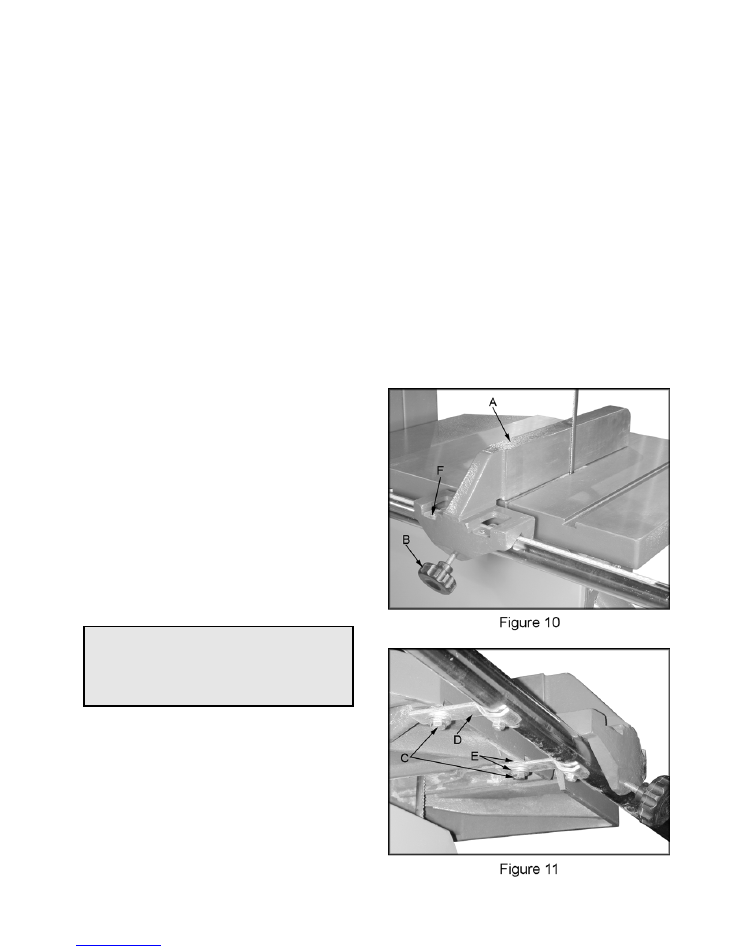
Fence and Rail Adjustment
Make sure the voltage of your power supply
matches the specifications on the motor plate of
the machine.
1. Place the fence (A, Figure 10) on the table
and guide tube. Use the knob (B, Figure 10)
to secure the fence in place, or loosen to
reposition fence.
1.
Disconnect machine from power source!
2. Remove nuts that secure the cover to the
connection box.
2. Move the fence so that the blade’s teeth just
touch the fence, see Figure 10. Lock the
fence in place using the knob.
3. Insert the power cable through strain relief,
and attach the wires to the terminals.
3. The fence should be parallel to the blade. If
not loosen the bolts (C, Figure 11) and
adjust the guide tube until the fence is
parallel to blade. Tighten the bolts.
4. Re-install the connection box cover. With
3Ph power verify the blade is turning in the
proper direction. Turn the bandsaw on and
make sure the blade travels in a clockwise
direction when viewed from the front. If it
does not, disconnect the machine from
power source and reverse any two incoming
power leads.
4. Raise or lower the fence and guide tube by
adding or subtracting flat washers (E, Figure
11) between the guide tube bracket and
table.
5. When wiring is completed, tape all power
box joints to keep out dust.
5. With a square verify the fence face is
perpendicular to the table top. If it is not you
will need to shim between the guide tube
bracket (D, Figure 11) and table at the low
end of guide tube.
5. Check to see that the pointer (F, Figure 10)
is aligned with the zero marking on the guide
tube. If adjustment is necessary loosen the
screw that holds the cursor in place and line
up to the zero mark. Tighten the screw.
6. Move the fence to the opposite side of blade
and check to make sure the cursor lines up
with zero mark. If adjustment is necessary
loosen the screw that holds the cursor in
place and line up to the zero mark. Tighten
the screw.
Electrical Connections
!
WARNING
Electrical connections and wiring must be
done by a qualified electrician. The machine
must be properly grounded. Failure to
comply may cause serious injury!
The bandsaw is available in both 1-Phase and
3-Phase versions.
•
Electrical Connections for a 3-Phase Unit
This bandsaw is 3-Phase, 220V/440V
pre-wired
220V
. If you need to switch the bandsaw from
220V to 440V have a qualified electrician make
the changes. Oliver Machinery recommends
using a dedicated circuit.
11
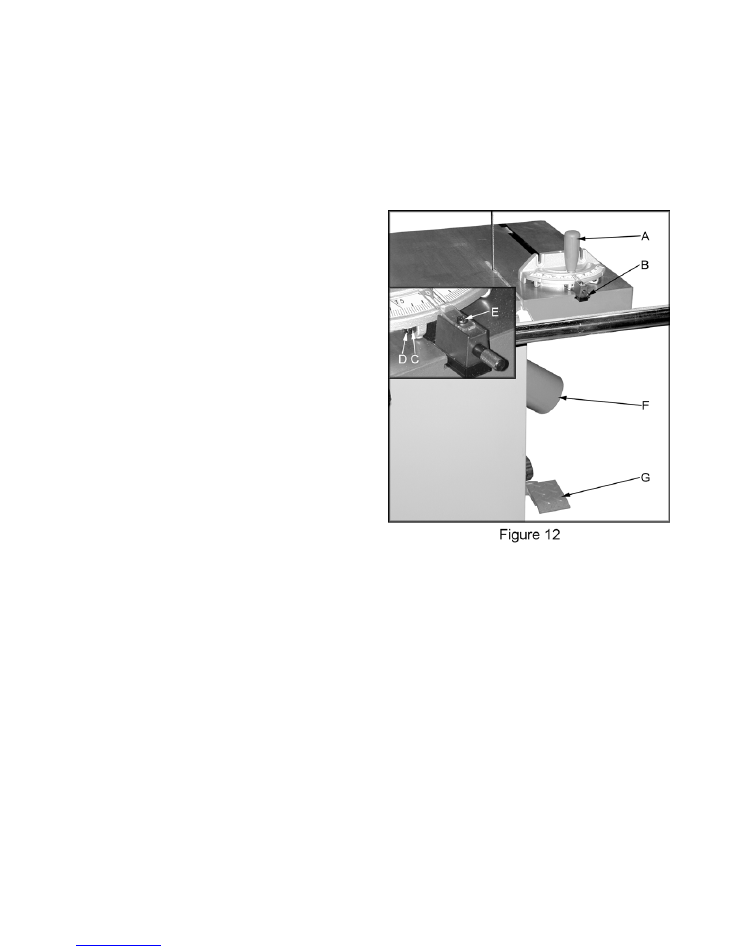
Tilting the Table
•
Electrical Connections for a 1-Phase Unit
This bandsaw is 1-Phase, 220V only. Oliver
Machinery recommends using a dedicated
circuit.
1.
Disconnect machine from power source.
2. Loosen the trunnion bolt found in the center
of the trunnions and tilt the table until the
scale reads the desired angle. Tighten the
bolt.
Note:
The scale is for reference and
should be checked with a combination
square if exact angles are needed.
Make sure the voltage of your power supply
matches the specifications on the motor plate of
the machine.
1.
Disconnect machine from power source!
2. Remove nuts that secure the cover to the
connection box.
3. Insert the power cable through strain relief,
and attach the wires to the terminals.
4. Re-install the connection box cover.
5. When wiring is completed, tape all power
box joints to keep out dust.
Miter Gauge
1. Slide the miter gauge bar into the miter
gauge slot in table. Loosen the handle (A,
Figure 12) and pull out indexing rod (B,
Figure 12) to pivot the miter gauge body.
2. Push the indexing rod in to engage the
preset stops.
3. Adjust stops by loosening the hex nut (C,
Figure 12) and adjusting screw (D, Figure
12).
4. Align the cursor by loosening screw (E,
Figure 12).
Note:
Always make test cuts. The scale is for
reference. There are two holes in the miter
gauge fence used to attach a wooden fence.
Dust Collection
There is a 4” dust port (F, Figure 12) located on
the side of cabinet. Make sure dust collection
system has sufficient capacity and suction for
your bandsaw. Always turn on dust collection
system before starting the bandsaw.
Brake Pedal
Press the brake pedal (G, Figure 12) while the
saw is running to stop the saw. Re-start the saw
by pressing the on switch.
12
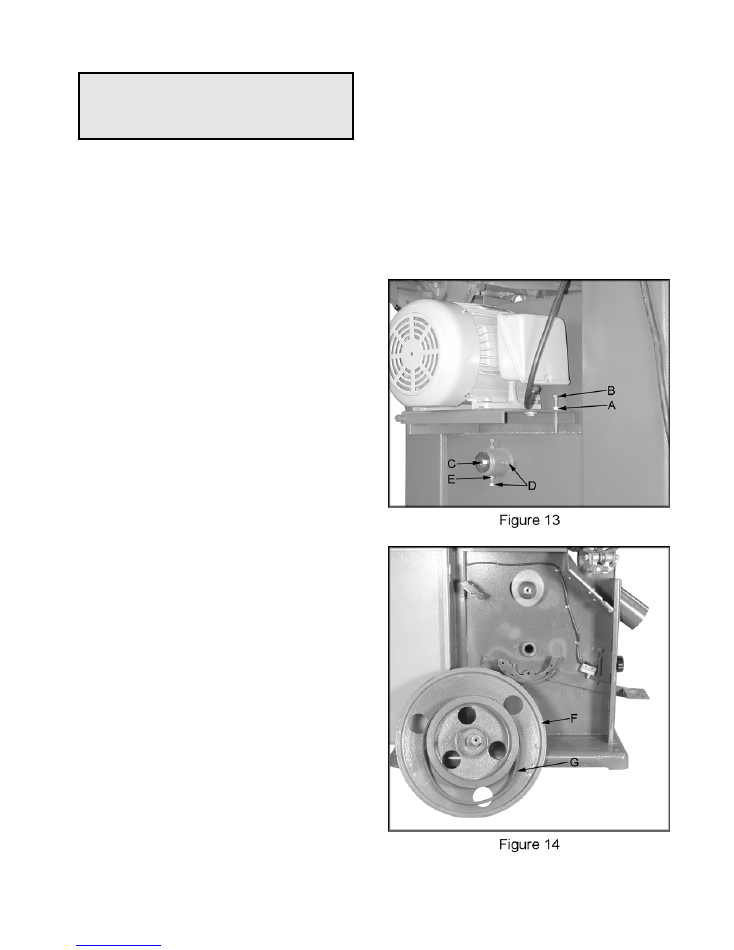
Removing Blades
12. Check the blade tracking, see “Blade
Tracking” page 8.
!
WARNING
Adjusting Belt Tension
Bandsaw blades are sharp so be very careful
while handling. Failure to comply may cause
serious injury!
1.
Disconnect machine from power source.
2. Loosen the hex nut (A, Figure 13) and turn
hex cap bolt (B, Figure 13) to raise or lower
the motor assembly. This will add or
remove tension to the v-belt.
1.
Disconnect machine from power source.
2. Open upper and lower doors completely.
3. Put on leather gloves to protect your hands
from the sharp teeth of blade.
3. Proper tension is achieved when there is a
1/4" deflection in the belt between pulleys
with light finger pressure.
4. Release blade tension and carefully remove
blade from upper and lower wheels.
Replacing V-Belt
1.
Disconnect machine from power source.
2. Release blade tension and carefully remove
blade from upper and lower wheels.
3. Loosen the hex nut (A, Figure 13) and turn
hex cap bolt (B, Figure 13) to lower the
motor assembly. This will take tension off
the v-belt. Stop when you can remove the
v-belt from the motor pulley.
4. Unscrew the bolt (C, Figure 13). Loosen
two of the shaft bolts (D, Figure 13) to
remove lower wheel.
Note:
don’t loosen
hex nuts (E, Figure 13).
5. Remove lower wheel assembly (F, Figure
14) by pulling from the front side. If the
lower wheel does not come off easily you
may need to loosen another shaft bolt (D,
Figure 13).
6. Remove the old belt (G, Figure 14) and
replace with a new belt.
7. Reinstall the lower wheel assembly and
make sure the v-belt is in the motor pulley
groove and wheel pulley groove.
8. Tighten bolt (C, Figure 13) and tighten shaft
bolts (D, Figure 13). Tighten hex nut (E,
Figure 13).
9. Turn hex cap bolt to adjust the belt tension,
see “Adjusting Belt Tension” page 13.
10. Reinstall the blade, see “Installing Blade”
page 8.
11. Set the blade tension, see “Tensioning
Blade” page 8.
13
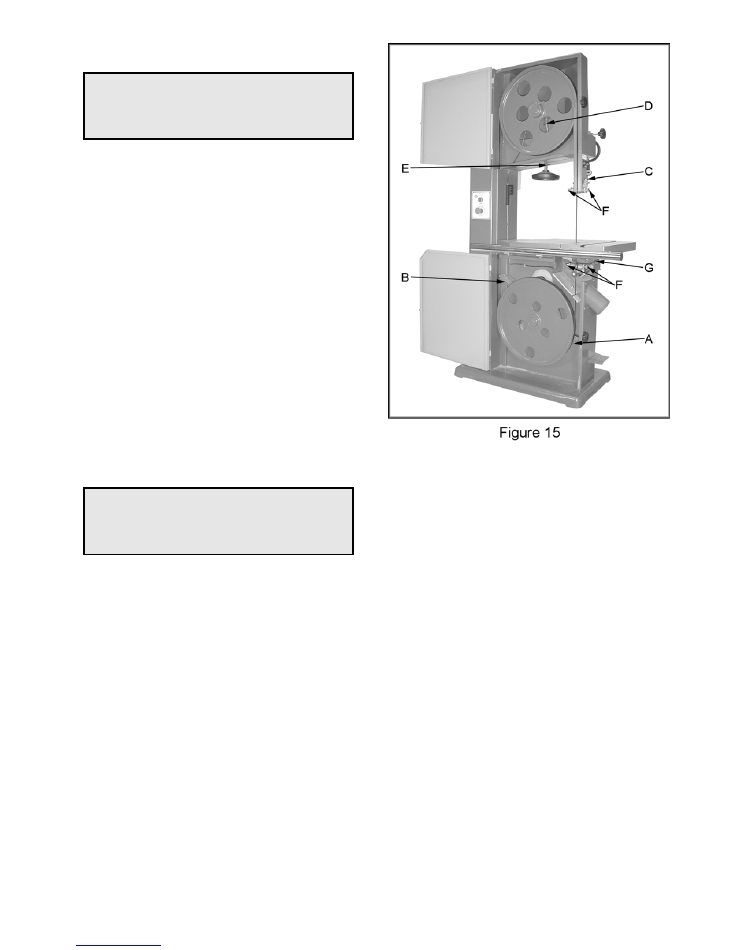
Maintenance
!
WARNING
Disconnect the machine from power source
before proceeding with any maintenance!
Failure to comply may cause serious injury!
Periodically clean the inside of the machine for
dust control. Use an air hose to blow out dust
from motor fan and motor cover.
Keep the brake switch (A, Figure 15) clean and
free of dust build up.
Adjust the lower wheel brush (B, Figure 15) to
make contact with the tire as the brush wares.
Keep pulleys and belts free from dirt, dust, oil
and grease.
Replace worn v-belt as needed.
Remove rust from the tabletop with WD-40 and
a Scotch-Brite™ Hand Pad. Keep a light coat of
WD-40
on the table top when not in use.
Keep the bandsaw blade sharp and clean.
Lubrication
!
WARNING
Disconnect the machine from power source
before proceeding with any lubricating!
Failure to comply may cause serious injury!
•
Clean and grease upper guide raising and
lowering rack (C, Figure 15) monthly, or as
needed.
•
Oil the dove tailed ways (D, Figure 15) that
the upper wheel slides on for blade tension
monthly, or as needed.
•
Grease the tensioning screw (E, Figure 15)
monthly, or as needed.
•
The guides (F, Figure 15) require oil daily or
every 8 hours of use. They have a ball
valve for oiling. We recommend 10 weight,
non-detergent oil.
•
Use a cloth to clean trunnion (G, Figure 15).
Apply white lithium grease to lubricate
trunnions.
14
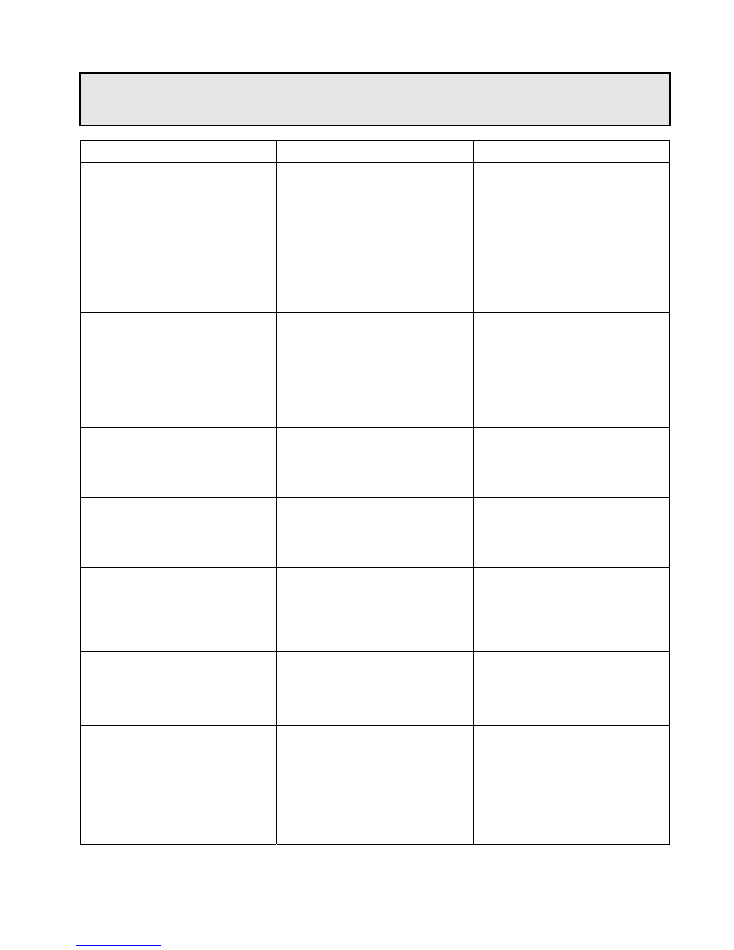
15
Troubleshooting
!
WARNING
Disconnect the machine from power source before proceeding with any troubleshooting! Failure
to comply may cause serious injury!
Description of Symptoms
Possible Cause
Corrective Action
Machine will not start
1. Fuse blown or circuit breaker
tripped
2. Cord
Damaged
3. Faulty
switch
4. Not connected to power
source
5. Connected to wrong voltage
6. Emergency stop button
pressed
1. Replace fuse or reset circuit
breaker
2. Have cord replaced
3. Replace
switch
4. Check
connection
5. Check
voltage
6. Rotate emergency stop button
clockwise until it pops out
Blade does not come up to speed
1. Cable too light or too long
2. Low
current
3. Circuit shared with other
equipment
4. Motor not wired for correct
voltage
1. Replace with adequate size
cable
2. Contact local electric
company
3. Provide a dedicated circuit
4. Refer to motor nameplate for
correct voltage
Motor overheats
1. Motor
overloaded
2. Air circulation through the
motor restricted
1. Reduce load on motor
2. Clean out fan and fan cover
Machine slows when operating
1. Feeding workpiece too fast
1. Slow the feed speed
Does not make accurate 45° or
90° cuts
1. Stops not adjusted correctly
2. Angle pointer not set
accurately
3. Miter gauge out of adjustment
1. Check blade with combination
square and adjust stops
2. Check blade with combination
square and adjust pointer
3. Adjust miter gauge
Saw makes unsatisfactory cuts
1. Dull
blade
2. Blade mounted backwards
3. Gum or pitch on blade
4. Incorrect blade for cut
1. Sharpen or replace blade
2. Turn blade around
3. Remove blade and clean
4. Change blade to correct type
Saw vibrates excessively
1. Stand on uneven floor
2. Damaged saw blade
3. Bad
V-belt
4. V-belt tension incorrect
5. Loose
hardware
1. Reposition on flat, level
surface
2. Replace saw blade
3. Replace
V-belt
4. Check and adjust v-belt
tension
5. Tighten
hardware